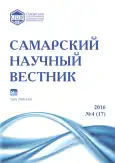Trophic behavior strategy of phytophagous insects (an example of leaf beetles Coleoptera, Chrysomelidae)
- Authors: Pavlov S.I.1
-
Affiliations:
- Samara State University of Social Sciences and Education
- Issue: Vol 5, No 4 (2016)
- Pages: 48-54
- Section: 03.02.00 – General Biology
- URL: https://journals.rcsi.science/2309-4370/article/view/22138
- DOI: https://doi.org/10.17816/snv20164109
- ID: 22138
Cite item
Full Text
Abstract
The feeding behavior and feed spectra of the active life phases (imago and larvae) of 25 background species of leaf beetles (Coleoptera, Chrysomelidae) were studied in Samara region during 1974-2014. The analysis of trophic relationships members of these insects associated with about 400 species of higher (angiosperms) plants from 50 families and 2 classes is interesting not only in terms of their agricultural value, but also when considering bioecology issues (clarification of possible contacts of the organism with the environment). The strategy of the feeding behavior of phytophagous is a complex, which includes 20 episodes of behavioral responses, focuses on the search and acquisition of food and requires choosing the right direction of the influences. Food specialization provides (in order to avoid competition between types of consumers) the existence a rich assortment of food resources and different ways of their use (herbivore and detritivore, optional - food pollen and predation, cannibalism - only 8 types). There are two groups of plants consumed by phytophagous. They are basic (normally developing larvae and imago) and additional (used by imago in unfavorable periods) plants. The search for insect food consists of three types of reactions. They are distant (coarse and fine setting) and contact reactions. Agricultural importance of leaf beetles is determined by not only damage to plants, but also the action stimulating the productivity of phytocoenosis.
Full Text
##article.viewOnOriginalSite##About the authors
Sergey Ivanovich Pavlov
Samara State University of Social Sciences and Education
Author for correspondence.
Email: ci-pavlov@yandex.ru
candidate of biological sciences, associate professor of Biology, Ecology and Methods of Teaching Department
Russian Federation, 443090, Samara, Antonov-Ovseenko street, 26References
- Медведев Л.Н., Зайцев Ю.М. Личинки жуков-листоедов Сибири и Дальнего Востока. М.: Наука, 1978. 184 с.
- Le Berre J.R. Examen critique des methods ľétude de ľalimentation chez les insectes // Ann. nutr. et aliment., 1963, 17, № 1, 249-277. Discuss., 277-282.
- Слоним А.Д. Среда и поведение: Формирование адаптивного поведения. Л.: Наука - ЛО, 1976. С. 15-35.
- Уждавини Э.Р. Врожденные пищевые реакции у тополевого листогрыза Melasona populi L. (Coleoptera, Chrysomelidae) // Тр. Ин-та физиол. АН СССР, 1968, 12, 163-170.
- Уждавини Э.Р. Пищевые реакции у личинок тополевого листогрыза (Melasona populi L.) // Проблемы изучения колорадского жука. М.: АН СССР, 1960. С. 182.
- Кохманюк Ф.С. Каннибализм, его экологическая и эволюционная роль // Поведение животных в сообществах: мат. 3-й Всесоюз. конф. по поведению животных. Т. 2. М.: Наука, 1983. С. 72-73.
- Медведев Л.Н., Самодерженков Е.В. Жизненные формы листоедов (Coleoptera, Chrysomelidae) // Экология жизненных форм почвенных и наземных членистоногих: Межвуз. сб. науч. тр. М.: МГПИ им. В.И. Ленина, 1986. С. 91-104.
- Махлаюк В.П. Лекарственные растения в народной медицине. М.: Нива России, 1992. 477 с.
- Banerjee T.C., Haqui N. Influence of host plants on development, fecundity and egg hatchability of the arctiid moth Diacrisia casignetum // Entomol. exp. et appl., 1985, 37, № 2, 193-198.
- Медведев Л.Н., Рогинская Е.Я. Каталог кормовых растений жуков-листоедов (Coleoptera, Chrysomelidae) фауны СССР. М.: ИЭМЭЖ им. А.Н. Северцова АН СССР, 1988. С. 13-23.
- Гринфельд Э.К. Происхождение и развитие антофилии у насекомых. Л.: ЛГУ, 1978. С. 68-91.
- Наумов Н.П. Экология животных: Учеб. пособие для гос. ун-тов. 2-е изд. М.: Высш. школа, 1963. С. 58-340.
- Neck Raymond W. Significance of visits by hackberry butterflies (Nymphalidae: Asterocampa) to flowers // J. Lepidopter. Soc., 1983, 37, № 4, 269-274.
- Du-Yong-jun, Yan-Fu-shun, Han-Xin-li, Zhang-Guang-xue // Kunchong xuebao = Acta entomol. sin. 1994. 37, № 4. С. 385-392.
- Павлов С.И. Влияние экологических факторов на адаптивное ориентировочное поведение жуков-листоедов (Coleoptera, Chrysomelidae) // Известия Самарского научного центра РАН. 2012. Т. 14. № 1. С. 120-124.
- Chockalingam S., Krishnan M. Influence of foliage age on food utilization in the final instar larva of a monophagous and a polyphagous insect pest // J. Adv. Zool., 1985, 5, № 1, 1-9.
- Павлов С.И. Временные бюджеты дневной активности жуков-листоедов (Coleoptera, Chrysomelidae) на разных этапах их генерационного цикла // Самарский науч. вестник. 2016. № 1(14). С. 47-51.
- Pouzat J., Pouzat M.H., Brocas J. La prise alimentaire chez Anthia sexmaculata F. (Caraboidea: Anthiidae) // Bull. Soc. scient. Bretagne. Sci. math., phys. et natur., 1966(1967), 41, № 3-4, 257-279.
- Prestidge R.A. Ingestion and assimilation efficiency of Aeshna brevistyla and Hemicordulia australiae larvae (Odonata) // N.Z.J. Mar. and Freshwater Res., 1979, 13, № 1, 193-199.
- Павлов С.И. Каннибализм как адекватная реакция животных на ухудшение условий обитания // Проблемы современной биологии: мат. VIII Международ. научно-практич. конференции (15.04.2013). М.: Спутник+, 2013. С. 51-56.
- Определитель сельскохозяйственных вредителей по повреждениям культурных растений / Ред. Г.Е. Осмоловский. Л.: Колос - ЛО, 1976. 696 с.
- Зайцев Ю.М., Медведев Л.Н. Личинки жуков-листоедов России. М.: ТНИ КМК, 2009. 246 с.
- Scriber J.M., Slansky F.Jr. The nutritional ecology of immature insects // Annu. Rev. Entomol. Vol. 26/ Palo Alto. Calif., 1981, 183-211.
- Бровдiй В.М. Екологiя i практичне значения жовтого вербового листоiда (Galerucella lineola F.) // Доповiнi АН УРСР, 1968, Б, № 2. С. 176-179.
- Мамедов А.А. Регуляция взаимоотношений в системе «фитофаг-кормовое растение» на примере хлопковой совки (Heliothis armigera Hb.) и хлопчатника // Пищевая специализация насекомых (экологический, физиологический, эволюционный аспекты) / ред. С.Я. Резник. СПб.: Гидрометеоиздат, 1993. С. 93-107.
Supplementary files














